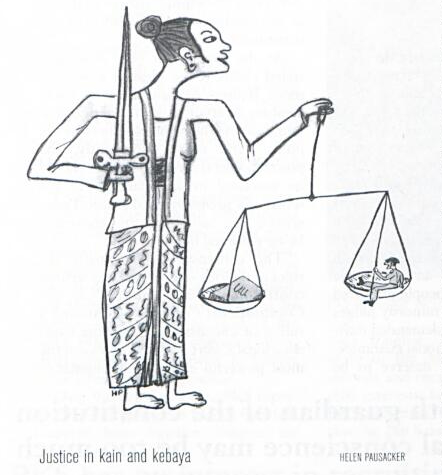Is there still a place for Inside Indonesia?
Lis Kramer
Inside Indonesia was born in 1983, only a few years after me. Up until the early 2000s I carried on blissfully unaware of its existence while it served as an important forum for the exchange of information and ideas about what was happening in Indonesia. More importantly, it published political and social critiques at a time when doing so domestically was a dangerous game. It was a publication focused on Indonesia, but not based in Indonesia. This allowed it to be fearless in its coverage. It offered commentary on Suharto’s regime, industrial relations, the role of women, and controversies in West Papua (then Irian Jaya) and East Timor. Many authors chose to publish under the name of an organisation rather than an individual, presumably to deflect attention and risk of retaliation.
In Suharto’s Indonesia, sharing certain types of knowledge could have real negative consequences. Also, with the internet still in its infancy it wasn’t so easy to distribute the publication—it was a hard copy or nothing at all.
The world has certainly changed, politically and technologically. Given how easy it is to publish, search and share information online today, is there still a place for Inside Indonesia? What value does an online publication focused on Indonesia, but run from Australia, hold today?
Neo-colonial?
As a scholar, part of me is anxious at the potential for neo-colonial undertones (or, let’s face it, overtones) that arise from persisting with such an endeavour. In pre-Reformasi days, publishing controversial opinions was difficult. Inside Indonesia offered a forum to Indonesian and foreign scholars and activists alike. It came with a commitment and love for Indonesia. Now, this rationale for existence is less compelling. There are plenty of Indonesian publications on a wide range of issues, including some once deemed controversial.

Inside Indonesia could easily fall into the trap of becoming a voice for foreigners wishing to ‘look in’ on Indonesia, offering analysis and commentary without being subject to the challenges the publication homes in on. The norm for foreign research on Indonesia (I include myself) is the fly-in fly-out visit, a dependence on in-country colleagues to collect ‘difficult’ data, then writing about Indonesia from home across the sea. Wearing batik at every opportunity as a performative nod towards cultural awareness can’t quite bridge the divide between observing and experiencing. Many of these practices come from necessity (well, perhaps not the batik-wearing). But warning bells ring nonetheless, inviting a minor existential crisis within me. What right do I have to comment on what happens in Indonesia when the politics don’t directly affect me? I remind myself that I am part Indonesian, but it doesn’t fully alleviate the anxiety.
It will always be a struggle to balance the value of outsider perspectives with the lived experience of those who embody the issues that scholars theorise about. And of course there are many shades in between, where the insider/outsider line begins to blur. But I think Inside Indonesia does a good job of navigating these tensions. It offers a unique blend of perspectives that give the reader a nuanced sense of what is happening in Indonesia. In going through the back catalogue of Inside Indonesia, I’m struck by the diversity of contributors it has always attracted. Although run mainly out of Australia, Indonesian contributors have always been prominent. Inside Indonesia offers a wide range of perspectives on lots of different topics.
The platform also makes it easy to share insights about Indonesia. It is internationally recognised, and posts articles for free. There is no barrier to access for anyone with a decent internet connection. For audiences from Indonesia to Australia, from Europe to North America and beyond, articles are just a click away.
Free and readable
Aspiring to openly share information is one of Inside Indonesia’s great continuities, a truly valuable contribution. Academics are encouraged to publish in 'prestigious' journals to demonstrate our worth. This is really a debate for another time, but it does mean our work is often locked away behind paywalls. Meanwhile, media organisations are increasingly monetising their online content with subscription fees, particularly for long-form journalism and opinion pieces. I know I use up my quota of free Jakarta Post and Tempo articles every month. In a world where information gatekeeping is growing more prevalent, Inside Indonesia remains a place where scholars, activists, students, and anyone else with a deep curiosity about Indonesia can freely read interesting, research-based pieces, and find a home for their own writing.
The accessibility of Inside Indonesia does not stop there. With articles in English, non-Indonesian readers have an opportunity to learn more about the country through a research-based lens. And authors are being helped to further broaden their reach by Inside Indonesia volunteers who make more and more articles available in both Indonesian and English.
Inside Indonesia articles avoid academic jargon and the long sentences many of us write when we ‘perform’ academia. This makes them more readable, for native and non-native English speakers alike. I know that even with my proficiency in Indonesian, it still takes me longer to read a piece in Indonesian than it does in English. By keeping the articles straightforward, Inside Indonesia is a more welcoming publication, consciously minimising that cognitive burden for a large proportion of its readers.
To return to my original question, is there still a place for Inside Indonesia today? Absolutely. It’s a place on the internet where Indonesian and non-Indonesian authors can share their insights, facilitated by international academics who feel at home in Indonesia. It does away with jargon and makes academic research more relatable and digestible. Plus, it’s free (not a Google ad in sight)! In a world where quality journalism on important issues is harder to come by, and where misinformation is rife on social media, this has got to be worthwhile.
Dr Elisabeth Kramer (e.kramer@unsw.edu.au) is an ARC DECRA and Scientia Fellow at the University of New South Wales.












